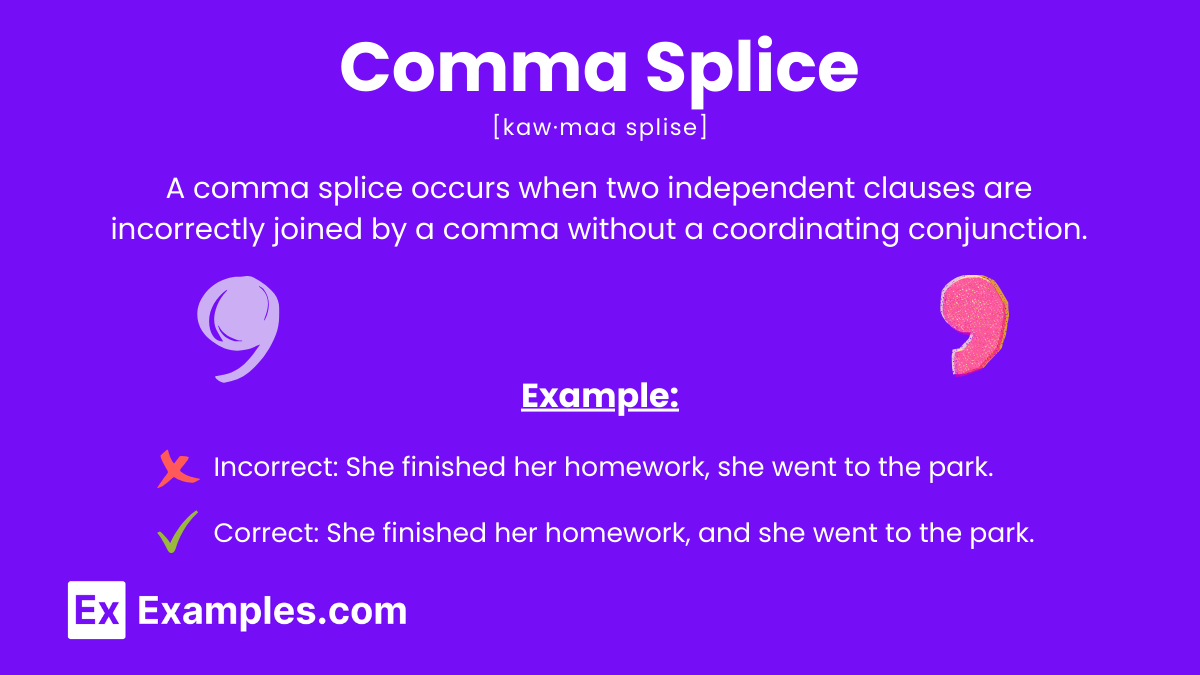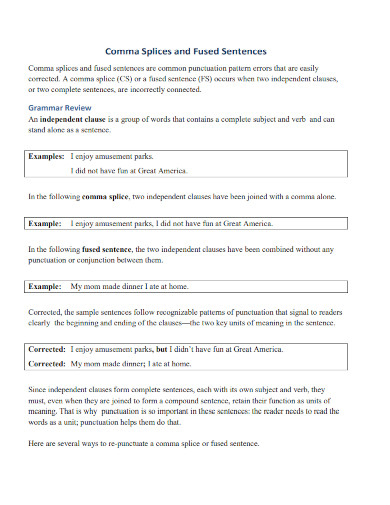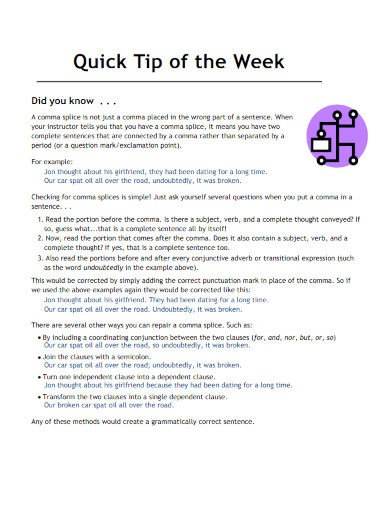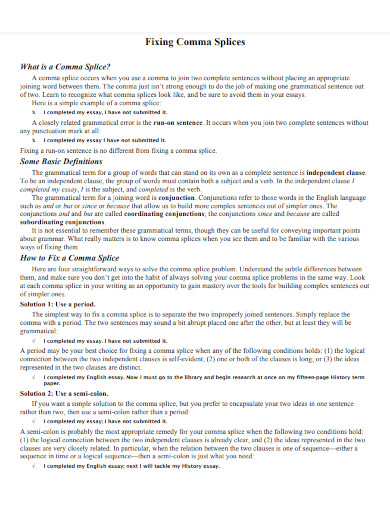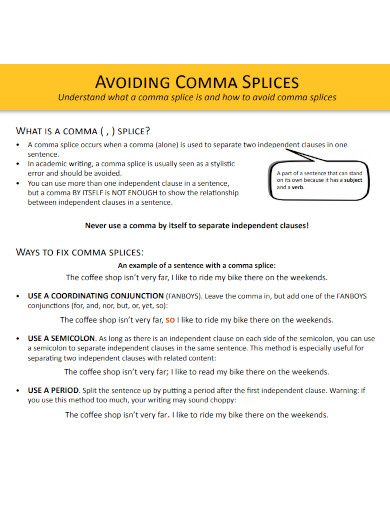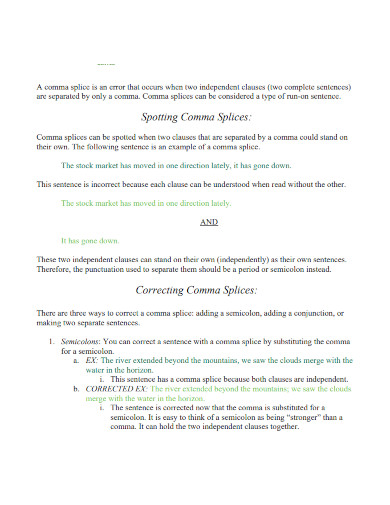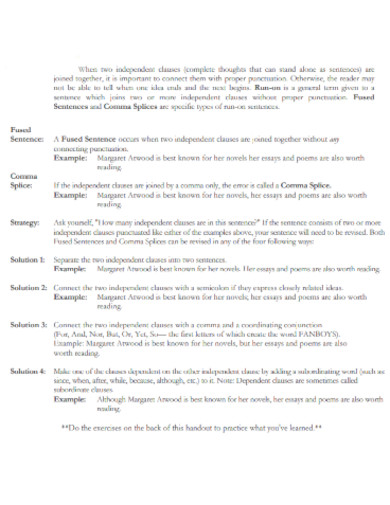28+ Comma Splice Examples
A comma splice occurs when two independent clauses are joined with only a comma, lacking a coordinating conjunction. This grammatical error creates a run-on sentence, making the text harder to read and understand. To correct a comma splice, you can use a period, a semicolon, or add a coordinating conjunction like “and,” “but,” or “so.” Properly addressing comma splices improves sentence clarity and overall writing quality.
There are many errors a writer can commit when they are writing a sentence, which will disrupt the flow of the whole text. One of the most common errors a writer makes is called a comma splice.
What Is a Comma Splice?
A comma splice is a sentence construction error, wherein the writer tries to fuse two or more independent clauses with a misplaced comma. This error presents a couple of issues that will mislead, confuse, and distract readers from your text. Try to avoid comma splices in your writing.
Examples of Comma Splice

Comma Splice Example Words
A comma splice occurs when two independent clauses are incorrectly joined by a comma without a coordinating conjunction.
Examples of Comma Splices
- However: She loves to read, however, she never finds the time.
- Therefore: He was hungry, therefore, he ate an entire pizza.
- Moreover: I enjoy hiking, moreover, it keeps me fit.
- Nevertheless: It was raining, nevertheless, we went for a walk.
- Then: She finished her homework, then, she watched TV.
- Also: I want to go to the party, also, I need to study for my exams.
- Besides: We were tired, besides, we had a long drive ahead.
- Otherwise: You need to hurry, otherwise, you’ll miss the bus.
Corrected Examples
- However: She loves to read; however, she never finds the time.
- Therefore: He was hungry; therefore, he ate an entire pizza.
- Moreover: I enjoy hiking; moreover, it keeps me fit.
- Nevertheless: It was raining; nevertheless, we went for a walk.
- Then: She finished her homework; then, she watched TV.
- Also: I want to go to the party; also, I need to study for my exams.
- Besides: We were tired; besides, we had a long drive ahead.
- Otherwise: You need to hurry; otherwise, you’ll miss the bus.
Comma Splice Error Examples
1. Comma Splice:
“I love ice cream, it’s my favorite dessert.”
Corrections:
- “I love ice cream. It’s my favorite dessert.”
- “I love ice cream; it’s my favorite dessert.”
- “I love ice cream, and it’s my favorite dessert.”
- “Because I love ice cream, it’s my favorite dessert.”
2. Comma Splice:
“He didn’t study for the exam, he still passed with flying colors.”
Corrections:
- “He didn’t study for the exam. He still passed with flying colors.”
- “He didn’t study for the exam; he still passed with flying colors.”
- “He didn’t study for the exam, but he still passed with flying colors.”
- “Although he didn’t study for the exam, he still passed with flying colors.”
3. Comma Splice:
“The weather was beautiful, we decided to go for a hike.”
Corrections:
- “The weather was beautiful. We decided to go for a hike.”
- “The weather was beautiful; we decided to go for a hike.”
- “The weather was beautiful, so we decided to go for a hike.”
- “Since the weather was beautiful, we decided to go for a hike.”
4. Comma Splice:
“She loves painting, her brother prefers sculpting.”
Corrections:
- “She loves painting. Her brother prefers sculpting.”
- “She loves painting; her brother prefers sculpting.”
- “She loves painting, but her brother prefers sculpting.”
- “While she loves painting, her brother prefers sculpting.”
5. Comma Splice:
“They were tired, they decided to rest for a while.”
Corrections:
- “They were tired. They decided to rest for a while.”
- “They were tired; they decided to rest for a while.”
- “They were tired, so they decided to rest for a while.”
- “Because they were tired, they decided to rest for a while.”
6. Comma Splice:
“The book was interesting, I couldn’t put it down.”
Corrections:
- “The book was interesting. I couldn’t put it down.”
- “The book was interesting; I couldn’t put it down.”
- “The book was interesting, so I couldn’t put it down.”
- “Since the book was interesting, I couldn’t put it down.”
7. Comma Splice:
“He finished his meal, he left the restaurant.”
Corrections:
- “He finished his meal. He left the restaurant.”
- “He finished his meal; he left the restaurant.”
- “He finished his meal, and he left the restaurant.”
- “After he finished his meal, he left the restaurant.”
8. Comma Splice:
“The project was due on Monday, we worked all weekend.”
Corrections:
- “The project was due on Monday. We worked all weekend.”
- “The project was due on Monday; we worked all weekend.”
- “The project was due on Monday, so we worked all weekend.”
- “Because the project was due on Monday, we worked all weekend.”
9. Comma Splice:
“I enjoy jogging in the morning, it helps me stay fit.”
Corrections:
- “I enjoy jogging in the morning. It helps me stay fit.”
- “I enjoy jogging in the morning; it helps me stay fit.”
- “I enjoy jogging in the morning, and it helps me stay fit.”
- “Since I enjoy jogging in the morning, it helps me stay fit.”
10. Comma Splice:
“She moved to a new city, she quickly made new friends.”
Corrections:
- “She moved to a new city. She quickly made new friends.”
- “She moved to a new city; she quickly made new friends.”
- “She moved to a new city, and she quickly made new friends.”
- “After she moved to a new city, she quickly made new friends.”
Comma Splice Examples Sentences
1. Comma Splice:
“I love to travel, I have visited many countries.”
Corrections:
- “I love to travel. I have visited many countries.”
- “I love to travel; I have visited many countries.”
- “I love to travel, and I have visited many countries.”
- “Because I love to travel, I have visited many countries.”
2. Comma Splice:
“The movie was great, I want to watch it again.”
Corrections:
- “The movie was great. I want to watch it again.”
- “The movie was great; I want to watch it again.”
- “The movie was great, so I want to watch it again.”
- “Since the movie was great, I want to watch it again.”
3. Comma Splice:
“She is a talented artist, her paintings are amazing.”
Corrections:
- “She is a talented artist. Her paintings are amazing.”
- “She is a talented artist; her paintings are amazing.”
- “She is a talented artist, and her paintings are amazing.”
- “Because she is a talented artist, her paintings are amazing.”
4. Comma Splice:
“We went to the park, we had a picnic.”
Corrections:
- “We went to the park. We had a picnic.”
- “We went to the park; we had a picnic.”
- “We went to the park, and we had a picnic.”
- “After we went to the park, we had a picnic.”
5. Comma Splice:
“He likes to read books, his sister prefers watching movies.”
Corrections:
- “He likes to read books. His sister prefers watching movies.”
- “He likes to read books; his sister prefers watching movies.”
- “He likes to read books, but his sister prefers watching movies.”
- “While he likes to read books, his sister prefers watching movies.”
6. Comma Splice:
“The sun is shining, it is a beautiful day.”
Corrections:
- “The sun is shining. It is a beautiful day.”
- “The sun is shining; it is a beautiful day.”
- “The sun is shining, so it is a beautiful day.”
- “Because the sun is shining, it is a beautiful day.”
7. Comma Splice:
“I finished my homework, I went to play outside.”
Corrections:
- “I finished my homework. I went to play outside.”
- “I finished my homework; I went to play outside.”
- “I finished my homework, and I went to play outside.”
- “After I finished my homework, I went to play outside.”
8. Comma Splice:
“She was tired, she went to bed early.”
Corrections:
- “She was tired. She went to bed early.”
- “She was tired; she went to bed early.”
- “She was tired, so she went to bed early.”
- “Because she was tired, she went to bed early.”
9. Comma Splice:
“The test was difficult, many students failed.”
Corrections:
- “The test was difficult. Many students failed.”
- “The test was difficult; many students failed.”
- “The test was difficult, so many students failed.”
- “Since the test was difficult, many students failed.”
10. Comma Splice:
“I cooked dinner, my friend brought dessert.”
Corrections:
- “I cooked dinner. My friend brought dessert.”
- “I cooked dinner; my friend brought dessert.”
- “I cooked dinner, and my friend brought dessert.”
- “After I cooked dinner, my friend brought dessert.”
More Templates on Common Splice in PDF
1. Comma Splices and Fused Sentences
2. Comma Splices Template
3. Fixing Comma Splices
4. Avoiding Comma Splices
5. Correcting Comma Splices
6. Fused Sentences and Comma Splices
Rules for Comma Splices
1. Identify Independent Clauses:
Ensure each part of the sentence can stand alone as a complete thought.
2. Avoid Using Just a Comma:
Do not connect two independent clauses with only a comma.
3. Use a Period:
Separate the independent clauses into two distinct sentences.
- Incorrect: “She loves reading, she has a vast collection of books.”
- Correct: “She loves reading. She has a vast collection of books.”
4. Use a Semicolon:
Link the independent clauses with a semicolon.
- Incorrect: “The sun was setting, we decided to head back.”
- Correct: “The sun was setting; we decided to head back.”
5. Add a Coordinating Conjunction:
Join the clauses with a comma and a coordinating conjunction (for, and, nor, but, or, yet, so).
- Incorrect: “He was tired, he went to bed early.”
- Correct: “He was tired, so he went to bed early.”
6. Use a Conjunctive Adverb:
Connect the clauses with a semicolon and a conjunctive adverb (however, therefore, moreover).
- Incorrect: “She didn’t study for the test, she still passed.”
- Correct: “She didn’t study for the test; however, she still passed.”
How to identify a Comma Splice?
1. Check for Independent Clauses:
Read the sentence to see if it contains two parts that can stand alone as complete sentences. An independent clause has a subject and a predicate and expresses a complete thought.
- Example: “I went to the store, I bought some bread.”
2. Look for a Comma:
Identify if there is a comma separating the two independent clauses.
- Example: “The sun set, the stars appeared.”
3. Absence of Coordinating Conjunction:
Ensure there is no coordinating conjunction (for, and, nor, but, or, yet, so) following the comma.
- Example: “She was hungry, she ate a sandwich.”
4. Determine Sentence Flow:
Read the sentence aloud to check for a natural pause. If the pause doesn’t feel like a complete stop but there’s no conjunction, it’s likely a comma splice.
- Example: “He finished his homework, he went out to play.”
How to correct a Comma Splice
Correcting a comma splice involves ensuring that two independent clauses are properly joined. Here are the main methods:
1. Use a Period:
Separate the independent clauses into two distinct sentences.
- Comma Splice: “She loves reading, she has a vast collection of books.”
- Corrected: “She loves reading. She has a vast collection of books.”
2. Use a Semicolon:
Link the independent clauses with a semicolon.
- Comma Splice: “The sun was setting, we decided to head back.”
- Corrected: “The sun was setting; we decided to head back.”
3. Add a Coordinating Conjunction:
Join the clauses with a comma followed by a coordinating conjunction (for, and, nor, but, or, yet, so).
- Comma Splice: “He was tired, he went to bed early.”
- Corrected: “He was tired, so he went to bed early.”
4. Use a Conjunctive Adverb:
Connect the clauses with a semicolon followed by a conjunctive adverb (however, therefore, moreover).
- Comma Splice: “She didn’t study for the test, she still passed.”
- Corrected: “She didn’t study for the test; however, she still passed.”
5. Restructure the Sentence:
Rewrite the sentence to subordinate one of the clauses.
- Comma Splice: “I enjoy reading, it’s very relaxing.”
- Corrected: “Because I enjoy reading, it’s very relaxing.”
Comma Splice vs. Fused Sentence
| Feature | Comma Splice | Fused Sentence |
|---|---|---|
| Definition | Two independent clauses joined by a comma alone | Two independent clauses joined with no punctuation |
| Example | “She loves reading, she has a vast collection.” | “She loves reading she has a vast collection.” |
| Error Type | Punctuation error | Punctuation error |
| Correction Methods | – Use a period | – Use a period |
| – Use a semicolon | – Use a semicolon | |
| – Add a coordinating conjunction | – Add a coordinating conjunction | |
| – Use a conjunctive adverb | – Use a conjunctive adverb | |
| – Restructure the sentence | – Restructure the sentence | |
| Impact on Reading | Causes a slight pause but feels incomplete | Causes run-on sentences, making it harder to read and understand |
| Common Mistakes | Overusing commas | Forgetting to add punctuation |
How to Fix a Comma Splice
Comma splices happens when the structure of the sentences do not match, and you end up with fragments, and run-on sentences. To know how to fix comma splices, here are simple and easy steps to guide you through these unwanted problems.
Step 1: Outline the Sentence
Begin by outlining the sentence structure of the statement with a comma splice. This will help you determine the independent clauses, the common, proper, singular, and plural nouns used in the statement, the verb, the tone, and the context/theme of the sentence.
Step 2: If Both Independent Clauses are Related, Determine the Type of Conjunction
When you have outlined the sentence’s parts, check if the independent clause has a relationship that will require both of them to be in a specific structure or sequence. For example, if the sentence is trying to establish a cause-and-effect relationship then you will need to use a conjunction to fix the sentence. Determine if you will need to use a subordinate or coordinating conjunction to fix the sentence.
Step 3: If Both Sentences Have Little to No Relationship With Each Other, Determine the Appropriate Punctuation Mark
If the sentence’s independent clauses are not related to one another or have little bearing on each other, you must instead remove the comma and replace it with the appropriate punctuation mark. These marks include the semicolon (;) and the period (.).
Step 4: Fix the Comma Splice
After you have determined how you will fix the comma splice, you will need to either remove the comma and insert the correct punctuation mark or add an appropriate conjunction beside the comma. Doing this will turn the comma splice into a complete sentence.
Why is a comma splice incorrect?
A comma splice creates a run-on sentence, which can make the text difficult to read and understand.
How can I fix a comma splice?
Use a period, semicolon, coordinating conjunction, or restructure the sentence to correct a comma splice.
Can I use a comma before “and” to fix a comma splice?
Yes, using a comma before a coordinating conjunction like “and” can fix a comma splice.
What is the difference between a comma splice and a fused sentence?
A comma splice incorrectly uses a comma, while a fused sentence joins two independent clauses without any punctuation.
Can a semicolon be used to correct a comma splice?
Yes, a semicolon can properly join two independent clauses, correcting a comma splice.
Is it always wrong to use a comma between two independent clauses?
Yes, without a coordinating conjunction, it creates a comma splice and is grammatically incorrect.
How does a comma splice affect readability?
Comma splices can confuse readers and disrupt the flow of the text, making it harder to understand.
Are comma splices common in writing?
Yes, comma splices are common errors, especially in informal writing, but they should be avoided for clarity.
Can conjunctions like “however” fix a comma splice?
Yes, using a semicolon before and a comma after conjunctive adverbs like “however” can correct a comma splice.
What are some common examples of comma splices?
“It was raining, we decided to stay inside.” Corrected: “It was raining; we decided to stay inside.”



